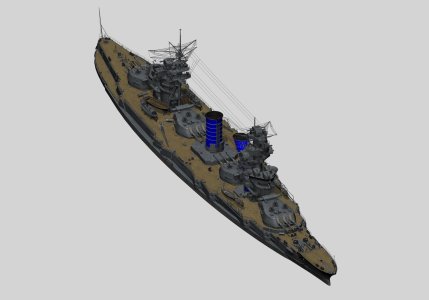The Gangut-class battleships, also known as the "Sevastopol class", were the first dreadnoughts begun for the Imperial Russian Navy before World War I. They had a convoluted design history involving several British companies, evolving requirements, an international design competition, and foreign protests. Four ships were ordered in 1909; two were named after victorious battles of Peter the Great in the Great Northern War and the other two were named after battles in the Crimean War. Three ships of the class used names of pre-dreadnought battleships of the Petropavlovsk-class lost in the Russo-Japanese War. Construction was delayed by financing problems until the Duma formally authorized the ships in 1911. They were delivered from December 1914 through January 1915, although they still needed work on the turrets and fire-control systems until mid-1915. Their role was to defend the mouth of the Gulf of Finland against the Germans, who never tried to enter, so the ships spent their time training and providing cover for minelaying operations. Their crews participated in the general mutiny of the Baltic Fleet after the February Revolution in 1917, and joined the Bolsheviks the following year. The Russians were forced to evacuate their naval base at Helsinki after Finland became independent in December 1917. The Gangut-class ships led the first contingent of ships to Kronstadt even though the Gulf of Finland was still frozen.
The two ships of the Baltic Fleet did not play a prominent role in the Winter War, but did have their anti-aircraft guns significantly increased before Operation Barbarossa in 1941. However this did not help either ship as they attempted to provide fire support for the defenders of Leningrad. Marat had her bow blown off and Oktyabrskaya Revolyutsiya was badly damaged by multiple bomb hits in September. The former was sunk, but later raised and became a floating battery for the duration of the Siege of Leningrad while the latter spent over a year under repair, although this was lengthened by subsequent bomb hits while in the hands of the shipyard. Both ships bombarded German and Finnish troops so long as they remained within reach, but Oktyabrskaya Revolyutsiya did not venture away from Kronstadt for the duration of the war. Parizhskaya Kommuna remained in Sevastopol until forced to evacuate by advancing German troops. She made one trip to besieged Sevastopol in December 1941 and made a number of bombardments in support of the Kerch Offensive during January–March 1942. She was withdrawn from combat in April as German aerial supremacy had made it too risky to risk such a large target.
The file contains all the sounds and pcx files. Model is not my own creation because it came from subsim and Valentine Abalihin (Vaa) is the author. Wyrmshadow provided the animation files and Ares de Borg did the sounds. I merely put the pieces together and cleaned up the model for CivIII and added some what if pieces. A big thanks to everyone that helped out!
The two ships of the Baltic Fleet did not play a prominent role in the Winter War, but did have their anti-aircraft guns significantly increased before Operation Barbarossa in 1941. However this did not help either ship as they attempted to provide fire support for the defenders of Leningrad. Marat had her bow blown off and Oktyabrskaya Revolyutsiya was badly damaged by multiple bomb hits in September. The former was sunk, but later raised and became a floating battery for the duration of the Siege of Leningrad while the latter spent over a year under repair, although this was lengthened by subsequent bomb hits while in the hands of the shipyard. Both ships bombarded German and Finnish troops so long as they remained within reach, but Oktyabrskaya Revolyutsiya did not venture away from Kronstadt for the duration of the war. Parizhskaya Kommuna remained in Sevastopol until forced to evacuate by advancing German troops. She made one trip to besieged Sevastopol in December 1941 and made a number of bombardments in support of the Kerch Offensive during January–March 1942. She was withdrawn from combat in April as German aerial supremacy had made it too risky to risk such a large target.
The file contains all the sounds and pcx files. Model is not my own creation because it came from subsim and Valentine Abalihin (Vaa) is the author. Wyrmshadow provided the animation files and Ares de Borg did the sounds. I merely put the pieces together and cleaned up the model for CivIII and added some what if pieces. A big thanks to everyone that helped out!

